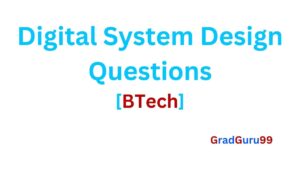Hello, Reader. Greetings from GradGuru99.com. Here are 60 short-answer questions for the Digital Electronics paper in the BCA syllabus. This is equally helpful for BE/BTech students.
Digital Electronics Question Set (BCA/BE/BTech)
- Define digital electronics.
- What is the basic unit of digital information?
- Differentiate between analog and digital signals.
- Define a logic gate.
- Provide an example of a combinational circuit.
- What is a truth table used for?
- Explain the concept of binary coding.
- Define the term “flip-flop.”
- Differentiate between synchronous and asynchronous circuits.
- Explain the purpose of a multiplexer.
- What is the function of an encoder?
- Define the term “half-adder.”
- Explain the significance of Karnaugh maps in digital design.
- What is a decoder in digital systems?
- Provide an example of a practical application of a shift register.
- Differentiate between a latch and a flip-flop.
- Define the term “complement” in the context of digital systems.
- Explain the operation of a 4-bit binary counter.
- What is the purpose of a comparator circuit?
- Define clock skew in synchronous systems.
- Explain the concept of asynchronous inputs in flip-flops.
- Differentiate between Mealy and Moore machines.
- Define the term “state” in sequential circuits.
- Explain the working principle of a tri-state buffer.
- Provide an example of a synchronous counter.
- What is the significance of the Master-Slave configuration in flip-flops?
- Define the term “race condition.”
- Explain the operation of a 3-to-8 line decoder.
- Differentiate between positive-edge and negative-edge triggered flip-flops.
- What is the purpose of a ring counter?
- Define the term “fan-out” in digital gate design.
- Explain the concept of clock gating.
- Differentiate between a 2-input XOR gate and a 2-input XNOR gate.
- Define the term “hazard” in digital circuits.
- Explain the working principle of a BCD-to-7 segment decoder.
- What is the purpose of a carry-lookahead adder?
- Define the term “don’t care condition” in Boolean algebra.
- Explain the concept of tristate output in digital circuits.
- Differentiate between CMOS and TTL logic families.
- Define the term “setup time” in flip-flops.
- Explain the purpose of asynchronous reset in flip-flops.
- What is clock domain crossing, and why is it important?
- Define the term “Gray code.”
- Explain the concept of dynamic hazards.
- Differentiate between synchronous and asynchronous counters.
- What is the function of a 4-to-16 line decoder?
- Define the term “cascading” in digital systems.
- Explain the working principle of a priority encoder.
- Differentiate between a parallel-in/serial-out and a serial-in/parallel-out shift register.
- Define the term “overflow” in binary addition.
- Explain the purpose of a carry flag in binary arithmetic.
- What is the purpose of clock distribution in digital systems?
- Define the term “ripple carry” in binary addition.
- Explain the significance of clock domain synchronization.
- Differentiate between positive logic and negative logic.
- What is the purpose of a 3-bit Johnson counter?
- Define the term “asynchronous up-counter.”
- Explain the concept of metastability in flip-flops.
- Differentiate between static and dynamic hazards.
- What is the purpose of a 5-input multiplexer?



![Read more about the article Digital Electronics semester paper 2023-2024 for MAKAUT BCA students [PDF download]](https://gradguru99.com/wp-content/uploads/2024/02/digital-electronics-23-24-makaut-bca-sem-Q-300x169.jpg)